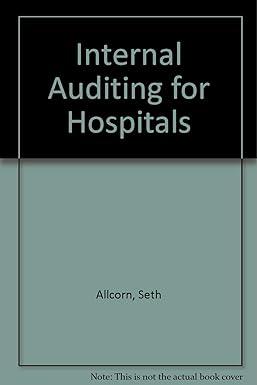
3.) You have reformulated the Imber Aedax Company's most recent financial statements and extracted the following information: Year ended 31 December 2019 $ million Sales 35,200 Interest expense minus interest income 291 Earnings before tax 13,168 Tax expense 2,384 Comprehensive income (CE) 11,809 As at 31 December 2019 Net operating working capital (OWC) Net non-current operating assets (NNCOA) Net financial obligations (NFO) $ million 936 42,287 11,906 a) Calculate NOA (net operating assets) and CSE (common shareholders' equity) at the end of 2019. (2 marks) b) Using the 2019 effective tax rate, calculate NFE (net financial expense) and I (operating income or NOPAT) for the year 2019. (5 marks) You now have the following forecast assumptions: 2020 2021 2022 thereafter Sales growth 10% 7% 4% 3% Ol/ sales 30% 25% 20% 18% Previous year OWC / this year's sales 2.2% 2.0% 2.0% Previous year NNCOA / this year's sales 105% 100% 98% NFO/NOA 27.5% 27.5% 27.5% 27.5% c) Predict sales and Ol for the years 2020 to 2022. Predict NOA, NFO and CSE for the years 2020 to 2022. (6 marks) d) Assuming that the 2019 tax rate continues to apply in future and that the cost of debt before tax shield benefit is 2%, find the after-tax cost of debt. Assuming that the cost of equity is 4.9% and using information given in the forecast table above, calculate the WACC (weighted average cost of capital). Round it to the nearest one tenth of a percent. Assuming that NFE equals previous year NFO times the after-tax cost of debt, calculate NFE and CE for the years 2020 to 2022. (6 marks) e) Calculate predicted AE (abnormal earnings), AOI (abnormal operating income or abnormal NOPAT) and FCF (free cash flow) for the years 2020 to 2022. (6 marks) 3.) You have reformulated the Imber Aedax Company's most recent financial statements and extracted the following information: Year ended 31 December 2019 $ million Sales 35,200 Interest expense minus interest income 291 Earnings before tax 13,168 Tax expense 2,384 Comprehensive income (CE) 11,809 As at 31 December 2019 Net operating working capital (OWC) Net non-current operating assets (NNCOA) Net financial obligations (NFO) $ million 936 42,287 11,906 a) Calculate NOA (net operating assets) and CSE (common shareholders' equity) at the end of 2019. (2 marks) b) Using the 2019 effective tax rate, calculate NFE (net financial expense) and I (operating income or NOPAT) for the year 2019. (5 marks) You now have the following forecast assumptions: 2020 2021 2022 thereafter Sales growth 10% 7% 4% 3% Ol/ sales 30% 25% 20% 18% Previous year OWC / this year's sales 2.2% 2.0% 2.0% Previous year NNCOA / this year's sales 105% 100% 98% NFO/NOA 27.5% 27.5% 27.5% 27.5% c) Predict sales and Ol for the years 2020 to 2022. Predict NOA, NFO and CSE for the years 2020 to 2022. (6 marks) d) Assuming that the 2019 tax rate continues to apply in future and that the cost of debt before tax shield benefit is 2%, find the after-tax cost of debt. Assuming that the cost of equity is 4.9% and using information given in the forecast table above, calculate the WACC (weighted average cost of capital). Round it to the nearest one tenth of a percent. Assuming that NFE equals previous year NFO times the after-tax cost of debt, calculate NFE and CE for the years 2020 to 2022. (6 marks) e) Calculate predicted AE (abnormal earnings), AOI (abnormal operating income or abnormal NOPAT) and FCF (free cash flow) for the years 2020 to 2022. (6 marks)







